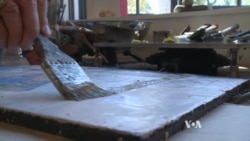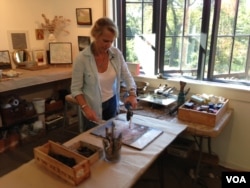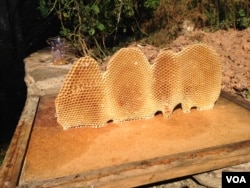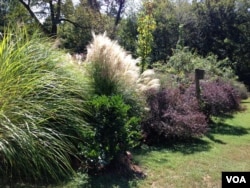Bees play an important part in Georgia Nassikas' life.
They provide fresh, rich honey for the artist’s dinner table, and she uses their wax in a special type of painting. It calls for combining and heating beeswax, natural color pigment and fir tree resin, called dammar, to create an enduring product.
The process, which dates back thousands of years, is called encaustic.
It's "a Greek word that means to ‘burn in,' " said Nassikas, who lives in the Washington suburb of McLean, Virginia. "Every layer of wax and pigment and dammar that goes on the surface needs to be fused with heat, so that one layer adheres to the layer below."
Ingredients from nature
Nassikas harvests the beeswax from several hives she keeps in her garden.
In her airy and spacious studio in a corner of the garden, she uses the natural warmth of the sun to melt the honeycombs into a rich, golden patty of wax. She then mixes that with dammar — which she has ground into a fine powder — and vibrant, Earth-sourced color pigments that she gets from around the world.
"And that’s the trio of ingredients that has made this, since the ancient Greeks, the Egyptians, [an] enduring form of art," she said.
She paints using a blowtorch and other heat-generating tools to seal in the layers. Sometimes she grinds charcoal and adds a bit of the fine powder to her images. Or she might add a little gold leaf, for contrast.
The result is artwork with soft, muted colors usually sourced and inspired by nature. Nassikas calls nature "a constant source of beauty, and that is the single most important ingredient in my work."
That is evident in a series the beekeeper created about her bees, who often are the subject of her paintings as well as a resource for honey and art supplies.
More than 40 percent of U.S. bee colonies have died this year from overuse of agricultural pesticides, disease, climate change and loss of habitat, the National Resources Defense Council reports.
“I did a series of paintings depicting my interpretation of colony collapse disorder by exploding the beehives,” Nassikas said.
The artist often presents her subjects, like her beehives, in geometric patterns and forms. "So often I look at a landscape and deconstruct it to its most elemental forms, and sometimes they look very architectural; sometimes they look very abstract," she said.
A family affair
Nassikas credits her love of painting to her genes.
"My mother’s side of the family has all been artists," she said. Paintings by her great-grandfather, George de Forest Brush, can be found at several prominent U.S. museums. Her aunt was a portrait painter, and her mother "always dabbled with little drawings of us on the beach or in her garden."
Her family also instilled in her a love of the natural world, which becomes obvious to anyone visiting her sun-filled home and lush, vibrant garden.
It’s filled with native flowers to attract bees, butterflies and other pollinators. Nassikas, who also raises chickens, has planted milkweed to attract monarch butterflies, an especially vulnerable species; sunflowers for the goldfinches; and a host of colorful, eco-friendly plants and flowers to encourage pollination.
"I come from a long line of gardeners and it's all about putting one's fingers in the earth to get the dirt under your nails," says Nassikas, who makes compost to supplement the soil. "So I personally couldn't help myself. ... It just came out of my fingertips."
Those fingertips have been busy: painting, planting, harvesting and serving creatures with whom she shares the Earth.















